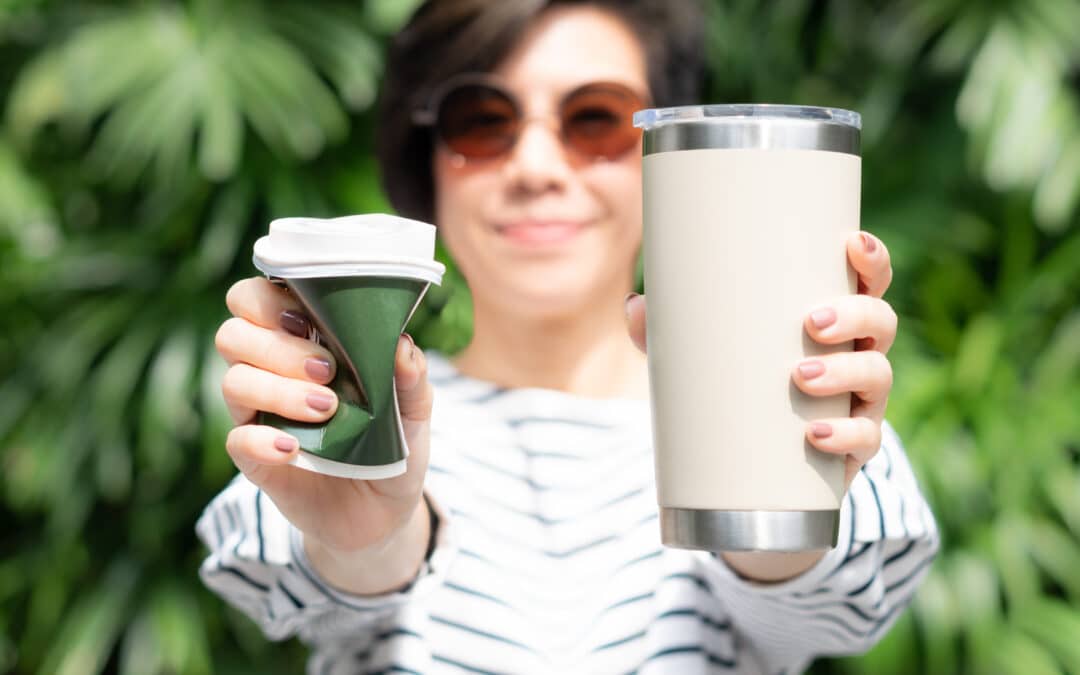De herziene Verpakkingsverordening introduceert nieuwe bepalingen voor o.a. hoogwaardige recycling, hergebruik, verboden producten en de invoering van statiegeld. Ook is de wetgeving veranderd van een richtlijn (directive) naar een verordening (regulation), waardoor het direct* van kracht is in de Europese lidstaten.
*De verordening bevat veel zogeheten ‘secondary legislation’ / ‘implementing acts’ en ‘delegated acts’ die pas op een later moment worden vastgesteld.
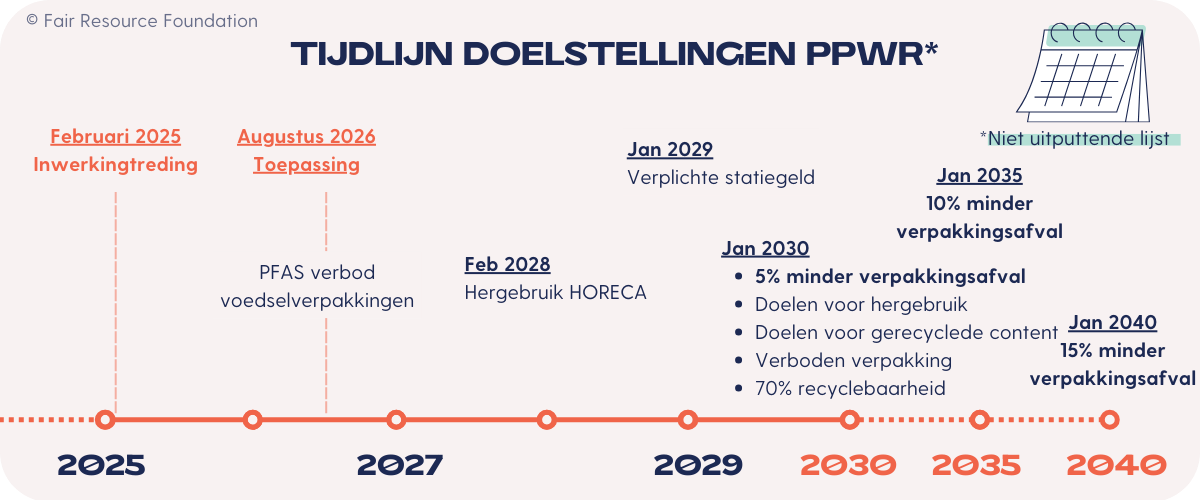
Beleidsproces
In november 2022 publiceerde de Europese Commissie (EC) haar voorstel voor de herziening van de – toen nog – Packaging and Packaging Waste Directive (PPWD). Voorafgaand aan deze officiële publicatie, was er al een eerdere versie van het voorstel gelekt. Hierin waren o.a. ambitieuze doelstellingen opgenomen voor herbruikbare verpakkingen en de toepassing van recycled content. De gelekte versie bracht veel commotie teweeg, vooral onder verpakkingsproducenten die het voorstel onhaalbaar achtten. Het uiteindelijke voorstel van de Europese Commissie was dan ook flink afgezwakt. Fair Resource Foundation schreef destijds een kritische analyse waarin de twee versies vergeleken worden.
Op het voorstel van de Europese Commissie volgden langdurige onderhandelingen in het Europees Parlement en de Raad van de Europese Unie, waarin de lidstaten vertegenwoordigd zijn. In november 2023, een jaar na de publicatie door de EC, stemde het Europees Parlement in met een sterk afgezwakte versie van het voorstel. Het bleek dat ongeëvenaarde lobbying vanuit het bedrijfsleven zijn vruchten had afgeworpen. Het Parlement schrapte bijna alle bepalingen om overbodige verpakkingen te verminderen, evenals het overgrote deel van de hergebruikdoelstellingen voor 2040. Sommige doelstellingen voor hergebruik (bijv. voor dranken) werden gehandhaafd, maar zodanig verlaagd en voorzien van uitzonderingen dat ze nog nauwelijks doelmatig zijn.
De lidstaten kwamen in de Europese Raad ook tot een gezamenlijke visie. Verschillende lidstaten, waaronder Nederland, hebben zich ingezet om het ambitieniveau van de Europese Commissie te behouden en, waar mogelijk, te verhogen. In december 2023 volgde de uiteindelijke positie van de Raad, waarin onder meer nieuwe hergebruikdoelstellingen werden voorgesteld en werd vastgehouden aan de afvalpreventiemaatregelen zoals voorgesteld door de Europese Commissie.
Het begin van 2024 stond in het teken van de zogeheten triloog-onderhandelingen tussen de Europese Commissie, het Parlement en de Raad om tot een akkoord te komen. Dit onderhandelingsproces werd in maart 2024 afgerond. Het resultaat: een verordening die voor het eerst Europese hergebruikdoelstellingen vastlegt, een einde maakt aan bepaalde overbodige verpakkingen, statiegeld in alle EU-lidstaten introduceert en duidelijke regels opstelt voor hoogwaardige recycling. Toch zorgen de vele uitzonderingsclausules voor achterpoortjes. Een gemiste kans, vinden wij.
Belangrijkste bepalingen
Aangezien de PPWR 70 artikelen bevat, willen we erop wijzen dat dit overzicht niet uitputtend is. In deze sectie geven we een overzicht van enkele van de belangrijkste punten van de herziening. De harmonisatie van etiketteringsvereisten, een direct verbod op PFAS, en het minimaliseren van lege ruimte in verpakkingen zullen we– ondanks hun belang– hieronder niet uitgebreid uiteenzetten.
[DO NOT DELETE] Invisible item so all accordeon is closed
Afvalpreventiedoelstelling
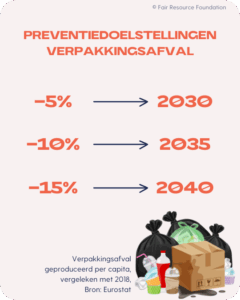
Een van de belangrijkste en meest ambitieuze elementen van de PPWR zijn de afvalpreventiedoelstellingen. Elke lidstaat moet hun gegenereerde verpakkingsafval met 5% verminderen tegen 2030, 10% tegen 2035 en 15% tegen 2040, vergeleken met 2018. Het is belangrijk te weten dat deze doelstellingen per lidstaat gelden en niet voor de Unie als geheel. Elke lidstaat zal proactief zijn eigen verpakkingsafval moeten verminderen.
De verboden en doelstellingen voor hergebruik, navullen, verpakkingsreductie en -minimalisering die door de verordening worden voorgesteld, zijn een essentiële eerste stap om die preventiedoelstellingen te bereiken. Gezien de huidige jaarlijkse toename van verpakkingsafval in veel lidstaten, is het echter te verwachten dat er aanvullende maatregelen nodig zullen zijn.
De PPWR laat ruimte voor – en moedigt – lidstaten aan om verder te gaan dan de eisen die zij stelt (overweging 149). Ze kunnen extra verboden invoeren en economische en fiscale prikkels gebruiken, zolang dit de interne EU-markt niet belemmert. Enkele van die aanvullende maatregelen omvatten het verbreden van de reikwijdte van statiegeldsystemen naar andere soorten verpakkingen voor eenmalig gebruik, zoals drankkartons en glas voor eenmalig gebruik (art. 50) of voor herbruikbare verpakkingen (art. 51). Fiscale en economische prikkels kunnen zich bijvoorbeeld vertalen naar extra belastingen of heffingen voor verpakkingen voor eenmalig gebruik die door distributeurs worden betaald, extra communicatievereisten of maatregelen op lokaal niveau. Het vastleggen van ambitieuzere hergebruikdoelen en het gebruik van UPV- en statiegeld-budgetten om reductie- en preventiemaatregelen te financieren, zijn ook aanvullende maatregelen die de lidstaten naar keuze kunnen implementeren.
Hergebruik- en navuldoelstellingen
Hoewel de invoering van bindende hergebruikdoelstellingen ernstig is afgezwakt tijdens het wetgevingsproces en door lobbyactiviteiten van de industrie, zoals de McDonald’s No Silver Bullet-campagne, zijn deze van cruciaal belang voor de opschaling van hergebruiksystemen voor verpakkingen in alle lidstaten.
- De B2B-sector wordt met name aangesproken, aangezien 40% van de transportverpakkingen binnen Europa in 2030 herbruikbaar moet zijn binnen een hergebruiksysteem, inclusief e-commerce en 70% in 2040 (niet-bindend). Binnen een gesloten omgeving (bijvoorbeeld een bedrijfslocatie), op de sites van een onderneming of tussen partners van dezelfde onderneming, moet 100% van de transportverpakkingen herbruikbaar zijn. Het is vermeldenswaard dat kartonnen dozen zijn uitgesloten van de verplichte hergebruikdoelstellingen, wat risico’s creëert van een ongewenste verschuiving naar meer kartonverpakkingsafval.
- Einddistributeurs moeten ervoor zorgen dat 10% van de verkoopverpakkingen van alcoholische en niet-alcoholische dranken en dozen voor het groeperen van verkoopverpakkingen (art. 29(5)) in 2030 hergebruikt wordt en moeten ernaar streven om in 2040 25% hergebruik te bereiken. Ze moeten er ook voor zorgen dat er voor 10% van hun producten die ze aanbieden, navulstations beschikbaar zijn.
- Ook de horecasector zal haar steentje moeten bijdragen door consumenten vanaf februari 2027 toe te staan hun eigen verpakkingen mee te nemen (BYO) en deze te laten vullen (art. 32). Vanaf februari 2028 zal de sector ook afhaalmaaltijden in herbruikbare verpakkingen moeten aanbieden voor warme en koude dranken en kant-en-klare maaltijden (art. 33).
Er werden veel vrijstellingen toegevoegd voor specifieke ondernemingen (micro-ondernemingen, kleinere einddistributeurs). Die vrijstellingen riskeren dat de hergebruiksystemen minder uniform worden en de communicatie naar consumenten minder duidelijk. Bovendien zijn kleine bedrijven vaak degenen die pionieren met het aanbieden van herbruikbare oplossingen voor consumenten.
Mogelijkheden om verder te gaan dan de PPWR : De PPWR staat lidstaten toe om hogere hergebruikdoelstellingen vast te stellen om de preventiedoelstellingen te halen (art. 29(15 en 16). Ze kunnen ook eisen dat fabrikanten en einddistributeurs herbruikbare verpakkingen beschikbaar stellen voor andere formaten dan die welke in de verordening zijn vermeld (art. 51(2)(c)).
Verboden
De PPWR bouwt voort op de richtlijn voor eenmalig plastic (SUPD) door vanaf januari 2030 nieuwe verboden op artikelen van eenmalig plastic in te voeren (art. 25 en bijlage V).
Vergeleken met de SUPD zullen de verboden harmonieuzer binnen de Unie worden ingevoerd, aangezien ze rechtstreeks van toepassing zijn op alle lidstaten. De verboden zullen het volgende omvatten:
- Groepsverpakkingen van plastic voor eenmalig gebruik (krimpfolie, verzamelfolie);
- Plastic verpakkingen voor eenmalig gebruik voor onbewerkte verse groenten en fruit;
- Verpakkingen van plastic voor eenmalig gebruik voor levensmiddelen en dranken die worden geconsumeerd voor consumptie in de HORECA;
- Plastic verpakkingen voor eenmalig gebruik voor specerijen, conserven, sauzen, koffiemelk, suiker en kruiden in de horeca;
- Verpakkingen voor eenmalig gebruik in de accommodatiesector, bestemd voor individuele boekingen;
- Zeer lichte plastic draagtassen;
Na sterke tegenstand van industriële lobby’s – en vooral de papierindustrie – hebben de verboden alleen betrekking op plastic verpakkingen voor eenmalig gebruik. Net als bij de verboden van de SUPD, ontstaat hierdoor het risico van een verschuiving van het ene materiaal voor eenmalig gebruik naar het andere, in plaats van een algehele vermindering van verpakkingen voor eenmalig gebruik.
Meer details over de formaten en vrijstellingen worden in februari 2027 gegeven in overleg met de EFSA en andere belanghebbenden. Dit zal ook essentieel zijn om de interactie met de SUPD en de status van de verboden die de lidstaten konden instellen, te bevestigen.
Mogelijkheden om verder te gaan dan de PPWR : Het is belangrijk te weten dat lidstaten die verboden hebben ingevoerd op zulke artikelen of artikelen gemaakt van andere materialen vóór 1 januari 2025, deze kunnen aanhouden.
Hoogwaardige recycling
Design for recycling

De PPWR streeft ernaar dat alle verpakkingen recyclebaar zijn. Vanaf 2030 wordt een beoordelingssysteem voor de recyclebaarheid van materialen op grote schaal ingevoerd (art. 6) met prestatieklassen van A tot C (zie afbeelding X). Dit om een maximale recyclebaarheid van verpakkingen te garanderen. Een definitie van de criteria voor “ontwerp voor recycling” voor heel Europa wordt uiterlijk 1 januari 2028 door de Europese Commissie vastgelegd. Vanaf 2030 moeten verpakkingen ontworpen zijn voor recycling en vanaf 2035 moeten ze op grote schaal recyclebaar zijn (uitvoeringsbesluit dat “op grote schaal recyclebaar” definieert komt er vanaf 1 januari 2030). Als verpakkingen niet voldoen aan de recyclebaarheidsdrempel van 70%, mogen ze vanaf 2030 niet meer op de EU-markt worden gebracht. In 2038 wordt de recyclebaarheidsdrempel verhoogd naar 80%.
De commissie zal rekening houden met verschillende elementen om de ontwerpcriteria voor recycling te definiëren, zoals duurzaamheid en een geografisch principe, om de nabijheid van recycling te bevorderen. Gezondheids- en veiligheidsaspecten zullen ook in aanmerking worden genomen, om ervoor te zorgen dat zorgwekkende stoffen worden vermeden.
Hoewel dit een belangrijke stap in de goede richting is, zal het even belangrijk zijn dat de Commissie een degelijke methode voorziet om de kwaliteit van gerecyclede grondstoffen van buiten de unie te controleren. Deze zogeheten“mirroring clause ” zal de veiligheid en kwaliteit van gerecycled plastic van buiten Europa waarborgen en tegelijk het concurrentievermogen van Europese recyclingbedrijven beschermen.
Recycled Content

Vanaf januari 2030 moet elke plastic verpakking die op de markt van de Unie wordt gebracht een minimale hoeveelheid gerecycled materiaal bevatten. Voor PET- en plastic drankflessen is dit 30%, voor andere contactgevoelige verpakkingen 10% en voor alle andere plastic verpakkingen 35%.
Dit zou een gamechanger kunnen zijn, omdat het meer gesloten-kringlooprecycling zou kunnen stimuleren (in tegenstelling tot open-kringlooprecycling, wat momenteel gebeurt met bijvoorbeeld PET-flessen die worden verwerkt tot kleding).
Zoals hierboven vermeld, brengt dit natuurlijk ook uitdagingen met zich mee. De controle op de kwaliteit van gerecyclede grondstoffen van buiten Europa en het risico dat er recyclingprocessen ontstaan die schadelijk kunnen zijn voor het milieu zijn er zo twee van.
Uitgebreide producentenverantwoordelijkheid (UPV)
De PPWR introduceert UPV-vereisten die voortbouwen op de Kaderrichtlijn Afvalstoffen. Vanaf augustus 2028 moeten verpakkingsproducenten geregistreerd staan in een nationaal register om verpakkingen op nationale markten te mogen plaatsen. Dit geldt ook voor online marktplaatsen (art. 45(4), die zich namens producenten zullen moeten registreren.
UPV-systemen zullen de extra kosten moeten dekken voor het labelen van afvalbakken voor de inzameling van verpakkingsafval en de kosten voor het uitvoeren van onderzoeken naar de samenstelling van ingezameld gemengd stedelijk afval (in geval van een dergelijke verplichting). Bovendien zullen UPV-heffingen moeten worden aangepast naargelang de recycleerbaarheidsprestaties (18 maanden na het in werking treden van het prestatieklassesysteem).
De lidstaten moeten ervoor zorgen dat hun nationale UPV-systemen en statiegeldsystemen een deel van hun budget reserveren voor de financiering van afvalreductie en -preventie (art. 51(3)).
Mogelijkheden om verder te gaan dan de PPWR : lidstaten krijgen de mogelijkheid om de kosten voor het opruimen van zwerfvuil op te nemen in de UPV-vergoedingen wanneer dit wordt gedaan door overheidsinstanties of namens producenten.
Statiegeldsystemen
De PPWR (art. 50) stelt dat een statiegeldsysteem (DRS) het inzamelsysteem bij uitstek is om een gescheiden inzameling van plastic flessen en blikjes van 90% te bereiken in 2029. Lidstaten zouden alleen onder strikte voorwaarden kunnen worden vrijgesteld van het installeren van zo’n systeem, waar momenteel geen enkel land – zonder statiegeld – voor in aanmerking komt. Die ambitieuze inzameldoelstelling maakt de weg vrij voor hoogwaardige recycling en vergemakkelijkt de overgang naar hergebruik (door hogere inzamelpercentages en -potentieel) en zwerfvuilvermindering. De suggestie binnen de PPWR om ook eenmalig glas en drankkartons hierin op te nemen (artikel 50(6)) ligt in lijn met het idee om een ambitieuze statiegeldwetgeving op EU-niveau in te voeren. De PPWR staat de uitsluiting van bepaalde verpakkingen toe op basis van inhoud (alcohol, zuivel). Die uitzonderingen vallen echter wel onder de doelstelling van 90% gescheiden inzameling.
De gedelegeerde handeling inzake de meting van gescheiden inzameling van plastic flessen en blikjes (in lijn met uitvoeringsbesluit 2021/1752 van de SUP) zal van cruciaal belang zijn om een goede monitoring van de effectiviteit van statiegeld mogelijk te maken. Deze secundaire wetgeving wordt verwacht in februari 2027.
Mogelijkheden om verder te gaan dan de PPWR : de verordening moedigt lidstaten aan om ook statiegeld in te voeren voor andere verpakkingen voor eenmalig gebruik (glas voor eenmalig gebruik, drankkartons) en herbruikbare verpakkingen (artikel 51(2)(a)).
Implementatie en opvolging
Zoals dit overzicht liet zien, is er nog veel secundaire wetgeving (gedelegeerde handelingen en uitvoeringshandelingen) nodig om de doelstellingen en de manier waarop deze moeten worden bereikt, te verduidelijken. Deze handelingen worden ontworpen door de Europese Commissie, in overleg met een diverse groep stakeholders. Het is van cruciaal belang dat maatschappelijke organisaties en milieuorganisaties bij dit proces betrokken blijven, om te voorkomen dat de wetgeving opnieuw wordt afgezwaktzoals gebeurde tijdens de triloog. De invloed van de industrielobby bij het afzwakken van de Europese Green Deal te verzwakken, is alom bekend.
Enkele van de belangrijkste aandachtspunten in de secundaire wetgeving zijn opgenomen in de onderstaande figuur:
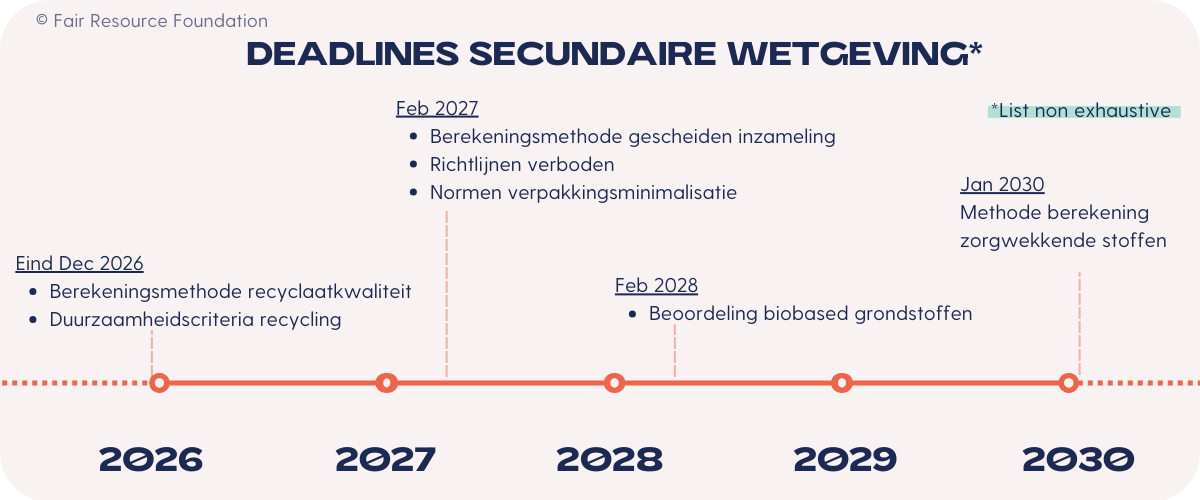
Gerelateerde tags

Stichting OPEN laat kansen voor versnelling circulaire transitie liggen bij AVV-aanvraag
Dit artikel analyseert de nieuwe AVV-aanvraag van Stichting OPEN voor e-waste. Het toont aan dat inzameldoelstellingen al jaren niet worden behaald, de governance vooral wordt bepaald door producenten en het Actieplan 2025–2030 nauwelijks inzet op hergebruik en levensduurverlenging. Daarnaast worden kritische vragen gesteld bij de werking van het AVV-instrument en de beperkte invloed van stakeholders binnen de consultatieprocedure.
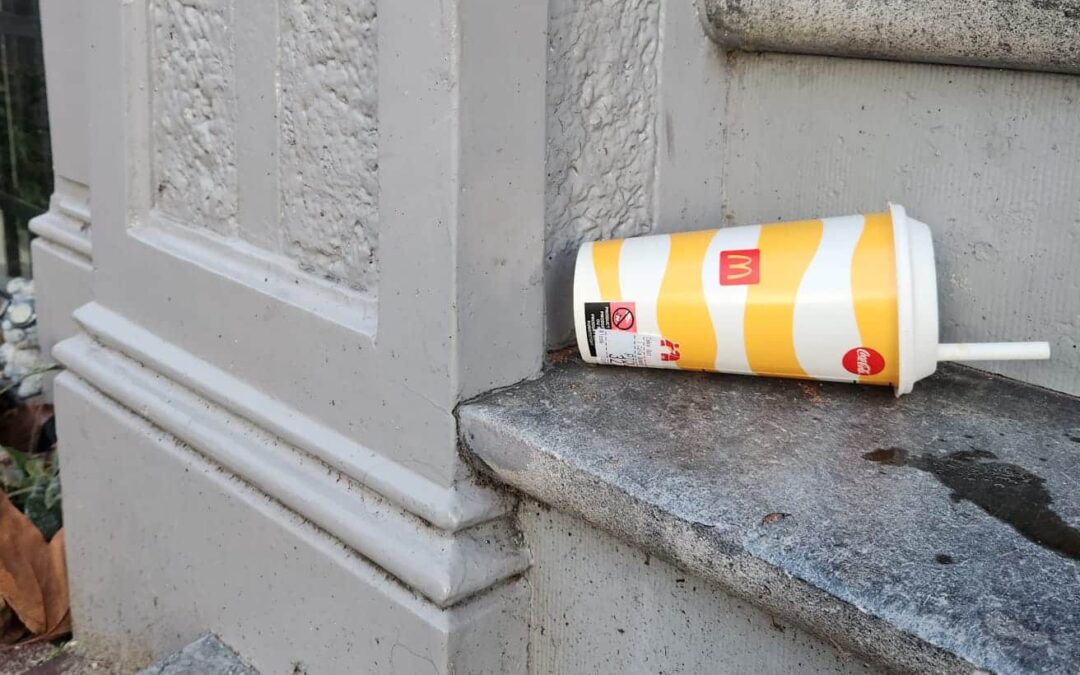
Klanten betalen de rekening voor de vervuiling van McDonald’s
Al twee jaar lang moeten alle horecagelegenheden in Nederland bij consumptie ter plaatse eten en drinken serveren in herbruikbare verpakkingen. Toch overtreedt McDonald’s Nederland sinds de zomer 2024 de wet door in haar restaurants eenmalige kartonnen bekers met plastic coating aan te bieden. Daarmee is de grootste fastfoodketen van het land niet alleen non-compliant en verspilt ze grondstoffen, maar ze laat consumenten er zelfs extra voor betalen door een toeslag te heffen op deze wegwerpbekers.
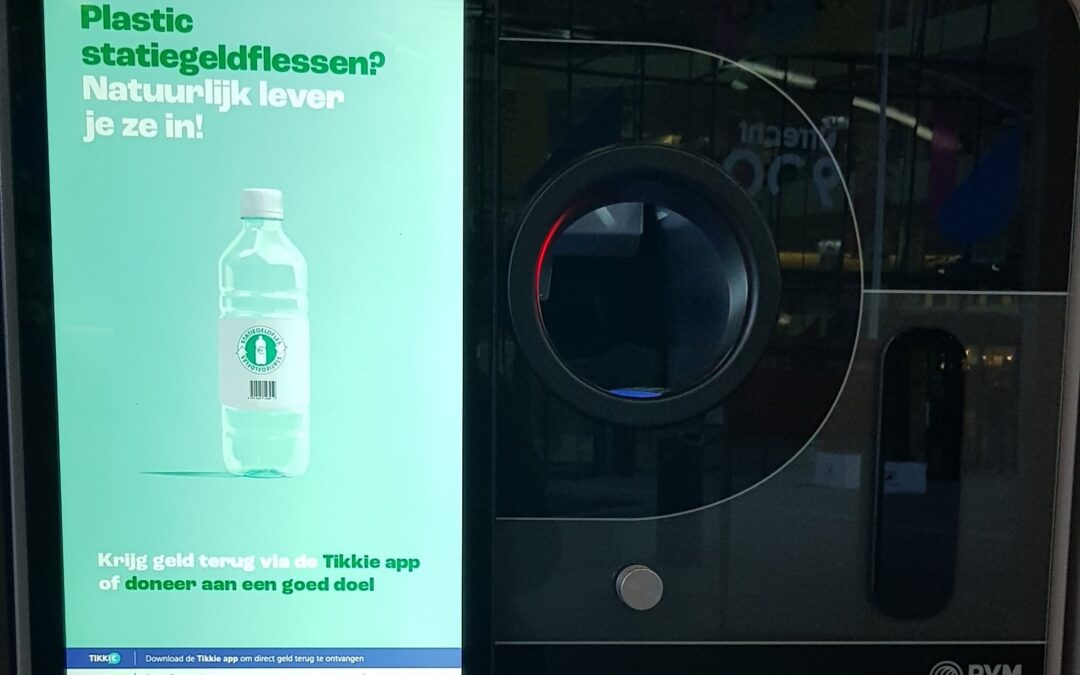
Verhoogd statiegeld, een retourbonus of een kansspel – veel te doen na tweede Last onder Dwangsom
De ILT legt Verpact een nieuwe dwangsom op omdat de inzameling van plastic flesjes te laag bleef. Verpact moet per 1 januari 2026 het statiegeld of een retourbonus met 15 cent verhogen. Verpact gaat in beroep; Fair Resource Foundation steunt de ILT. De Raad van State beslist op 4 december.
